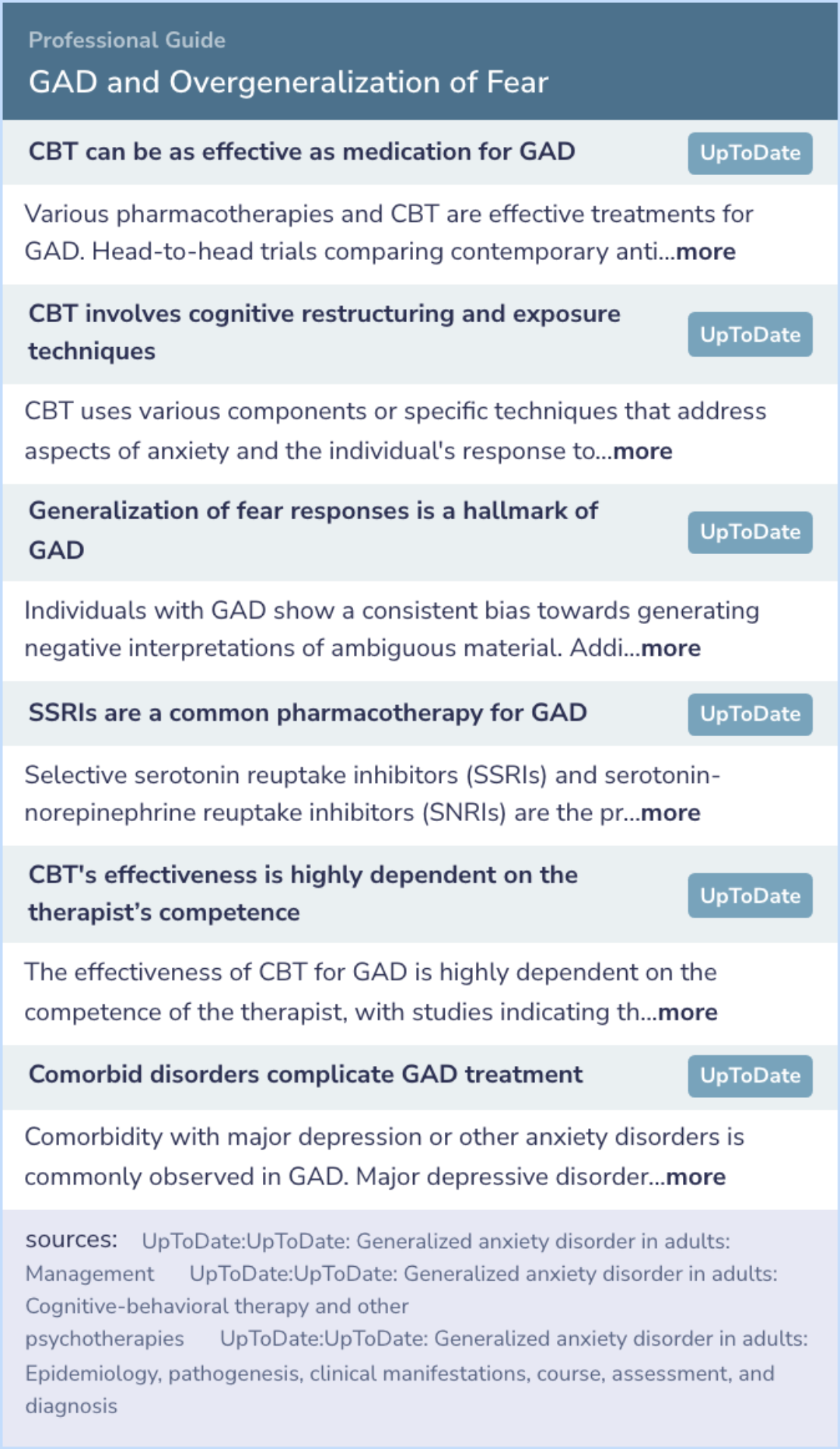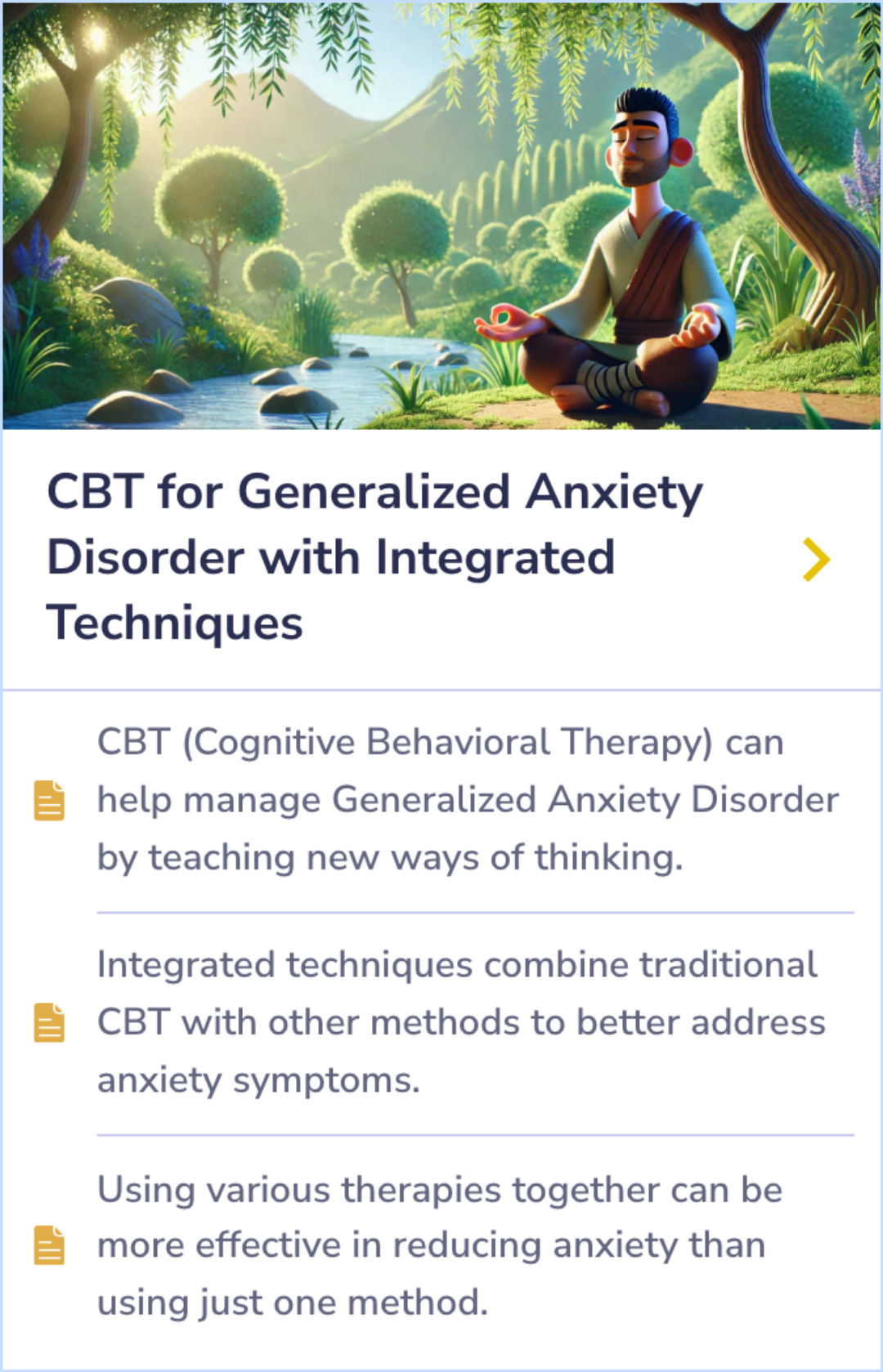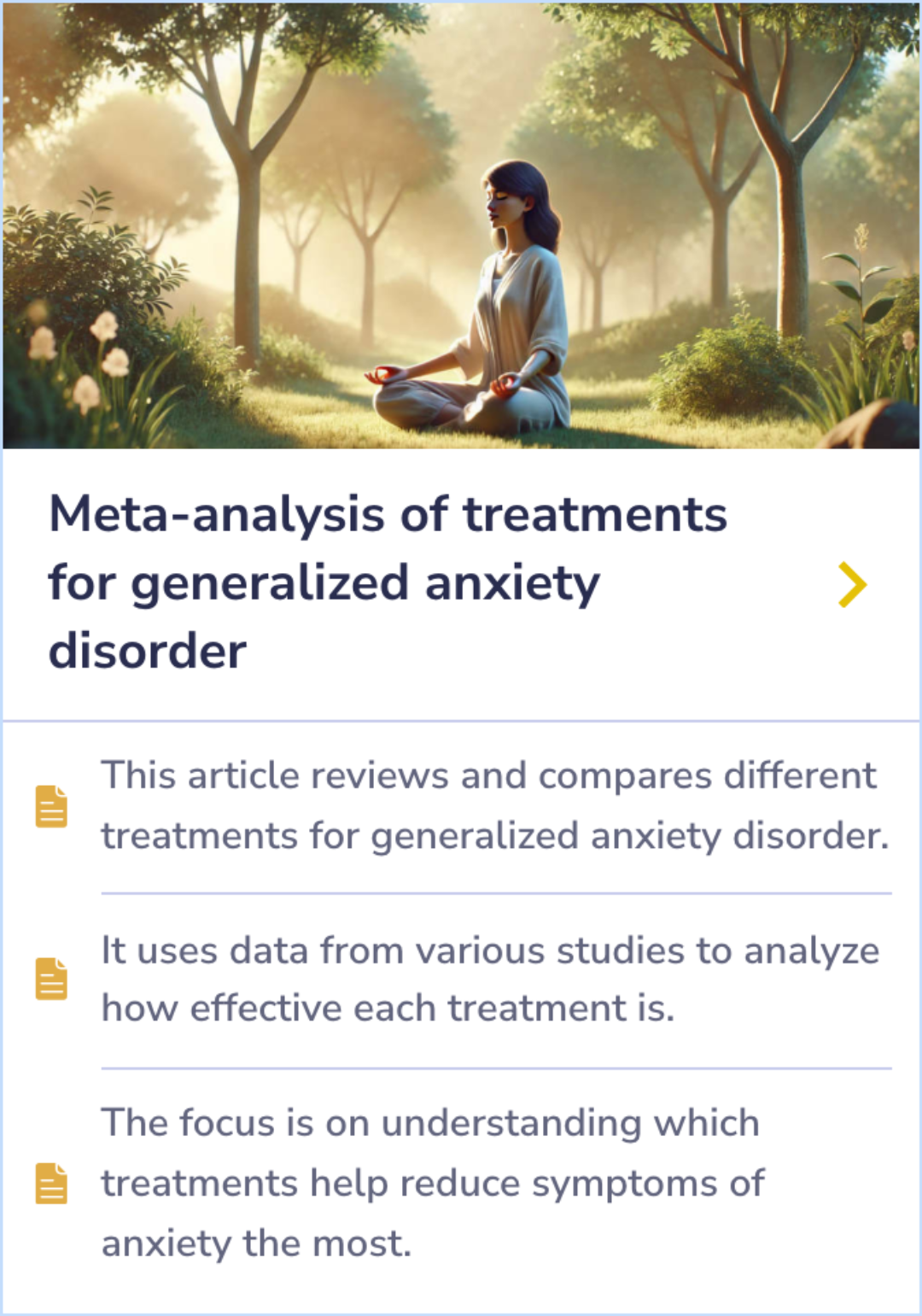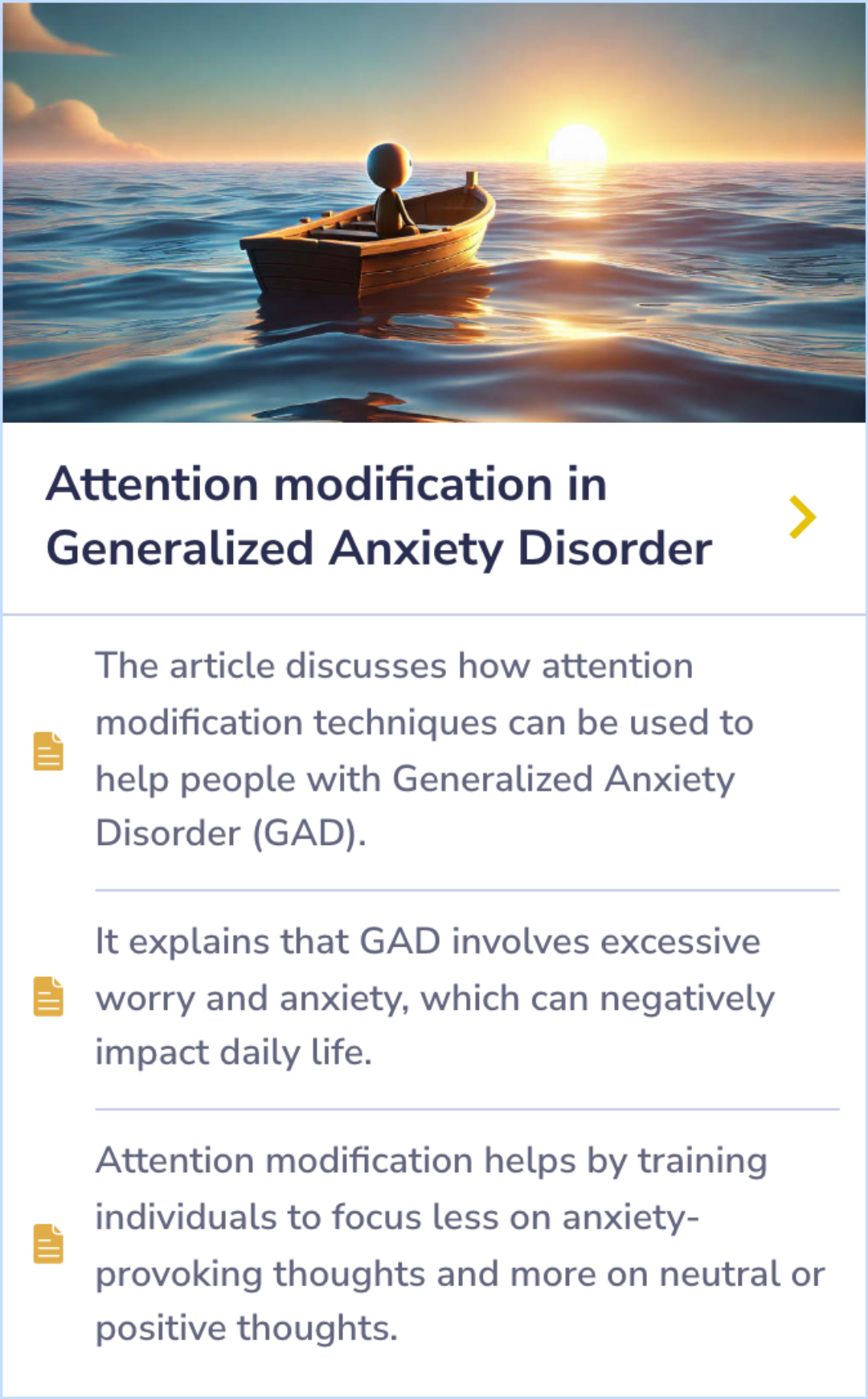Generalized Anxiety Disorder Papers
Visual Abstract
Generalized anxiety disorder is associated with overgeneralization of classically conditioned fear
GAD and Overgeneralization of Fear
November 25, 2024
author
Lissek S, Kaczkurkin AN, Rabin S, Geraci M, Pine DS, Grillon C
journal
Biol Psychiatry
Date Published
2014 Jun 1
Why link to a visual abstract?
What is a visual abstract?
Original
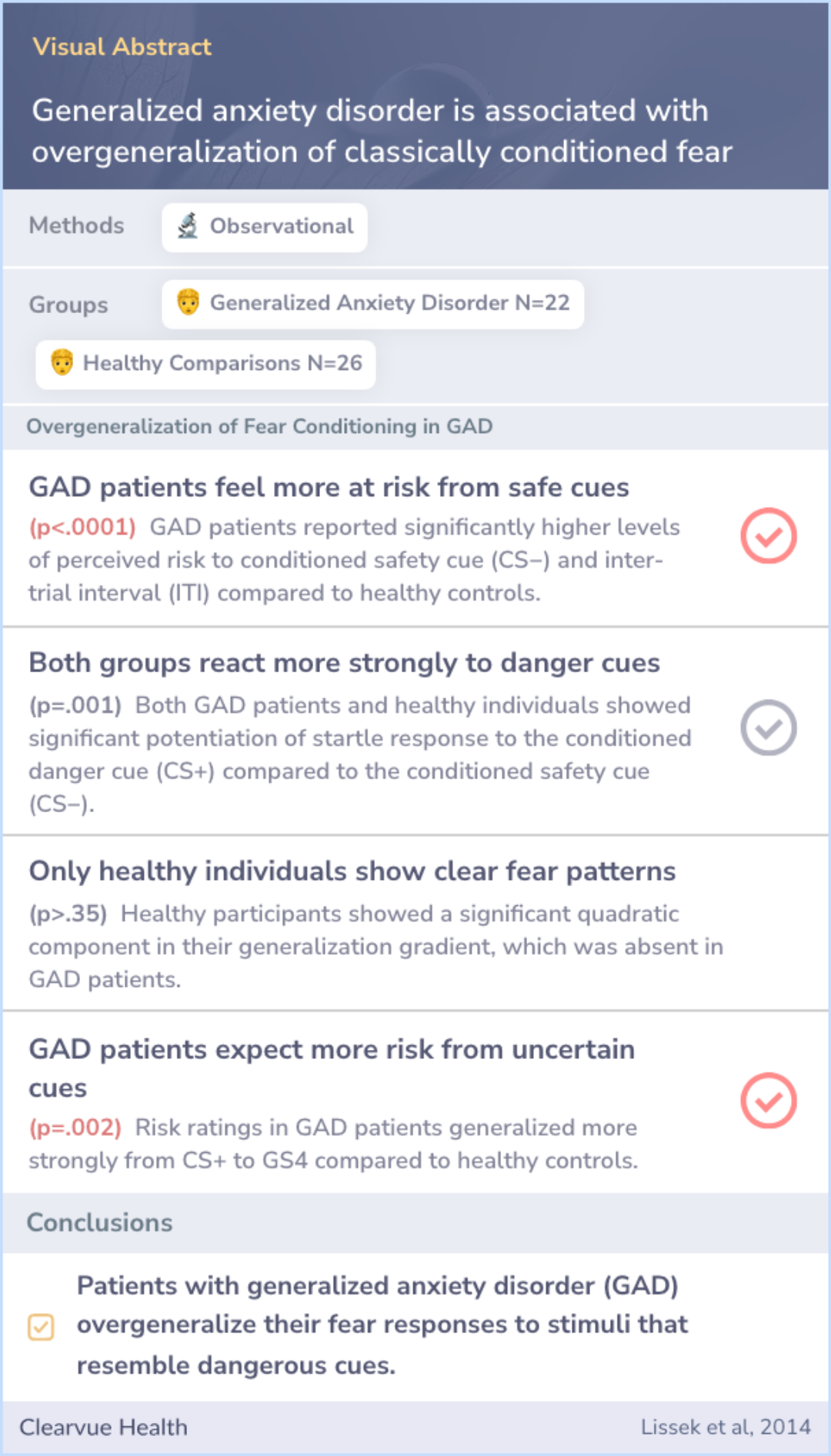
Study Summary
🔬
What They Studied
The study explored how people with generalized anxiety disorder (GAD) generalize conditioned fear compared to those without GAD.
💡
What They Found
They found that people with generalized anxiety disorder (GAD) overgeneralize conditioned fear, showing less of a decrease in fear response as the stimuli became less similar to the fear-inducing cue.
📚
What This Means
The findings suggest that overgeneralization of fear in individuals with generalized anxiety disorder (GAD) might make them more prone to anxiety by responding with fear to a wide range of stimuli that resemble dangerous situations, as highlighted in current research.
Study Summary
Study Overview
This study aimed to explore how individuals with generalized anxiety disorder (GAD) might overgeneralize fear responses to situations that are not truly threatening. By observing these responses, researchers hoped to understand the everyday impacts of fear on those with GAD. The findings reveal a clearer picture of how excessive fear can stem from ambiguous cues, possibly leading to increased anxiety in daily life.
Researchers suggest that this overgeneralization is a core feature of GAD and can affect how individuals respond to their environment, linking basic research to clinical observations.
Researchers suggest that this overgeneralization is a core feature of GAD and can affect how individuals respond to their environment, linking basic research to clinical observations.
Abstract: background
Meta-analytic results of fear-conditioning studies in the anxiety disorders implicate generalization of conditioned fear to stimuli resembling the conditioned danger cue as one of the more robust conditioning markers of anxiety pathology. Due to the ...more

Overgeneralization and Anxiety
"Overgeneralization of conditioned fear, to safe encounters resembling feared situations, may contribute importantly to the psychopathology of GAD by proliferating anxiety cues in the individual’s environment that are then capable of evoking and maintaining anxiety and worry associated with GAD."
GAD as a Broader Vulnerability
"Such findings suggest that overgeneralization of conditioned fear is not just a feature of GAD but may be a broader vulnerability marker cutting across traditional anxiety disorder categories."
Everyday Threat Perception
"These results highlight how overgeneralization in GAD may serve as a mechanism through which everyday situations can be perceived as threats, leading to chronic anxiety."
Study Summary
Methods
Researchers recruited 22 participants diagnosed with generalized anxiety disorder (GAD) and 26 healthy individuals as a comparison. Participants were shown rings of different sizes, with the largest and smallest representing danger and safety.
They measured fear using both muscle responses and self-reported anxiety as the ring sizes changed, assessing how participants generalized fear to stimuli that resembled the danger cues.
They measured fear using both muscle responses and self-reported anxiety as the ring sizes changed, assessing how participants generalized fear to stimuli that resembled the danger cues.
Abstract: methods
Twenty-two patients with a DSM-IV-TR diagnosis of GAD and 26 healthy comparisons were recruited and tested. The employed generalization paradigm consists of quasi-randomly presented rings of gradually increasing size, with extreme sizes serving as co...more

Study Summary
Results
People with generalized anxiety disorder (GAD) showed greater fear generalization, meaning their fear response did not fade much when presented with safer stimuli. This was evident in both their physical reactions and self-reported anxiety.
In comparison, those without GAD showed a more normal reduction in fear as the stimuli became less like the original danger cue, highlighting a key difference in how fear is processed in GAD patients.
In comparison, those without GAD showed a more normal reduction in fear as the stimuli became less like the original danger cue, highlighting a key difference in how fear is processed in GAD patients.
Abstract: results
Behavioral and psychophysiological findings demonstrate overgeneralization of conditioned fear among patients with GAD. Specifically, generalization gradients were abnormally shallow among GAD patients, reflecting less degradation of the conditioned ...more
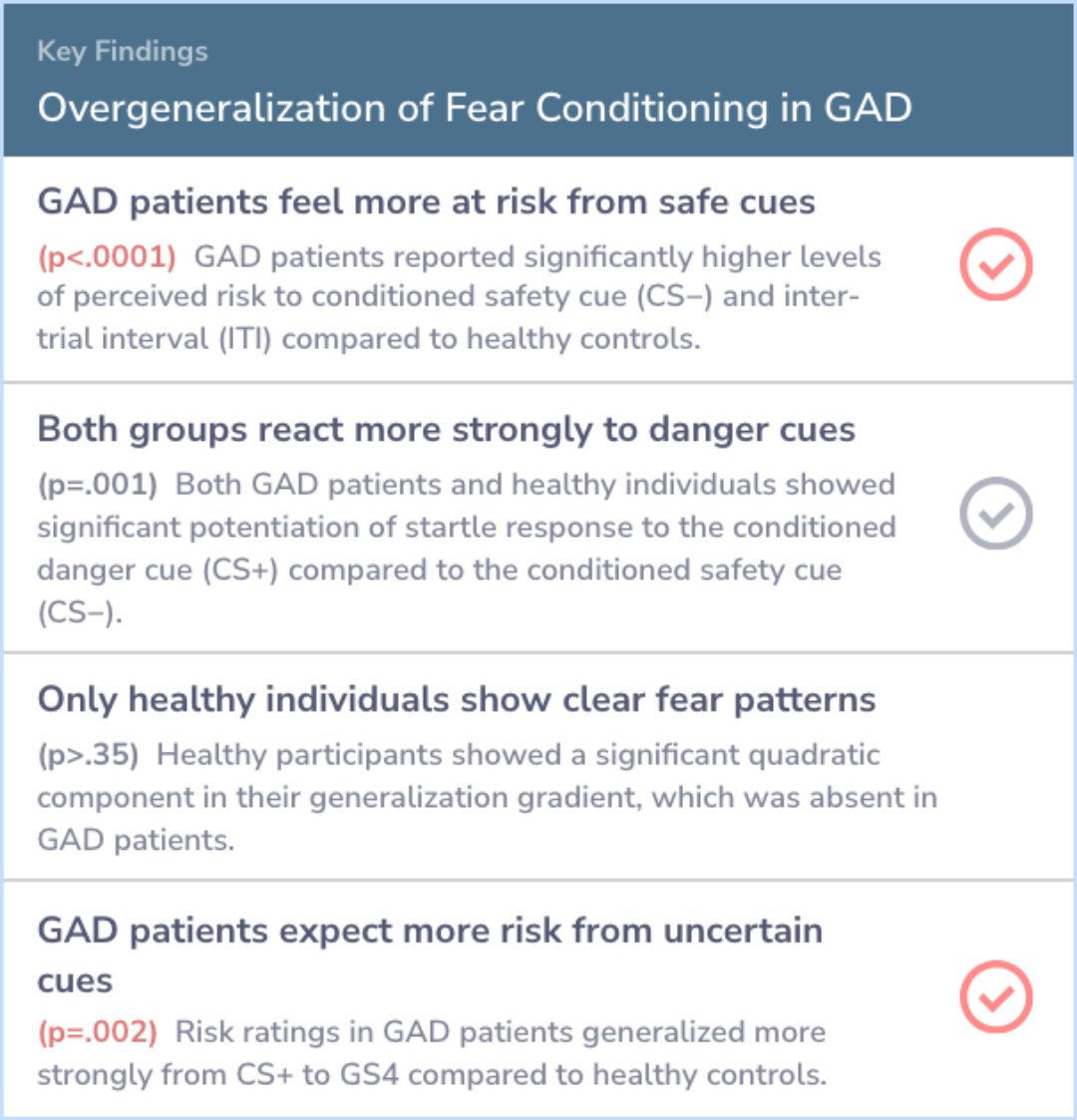
Study Summary
Conclusions
The study suggests that overgeneralization of fear may be a key factor in generalized anxiety disorder (GAD). People with GAD might continue to feel anxious in safe situations simply because they resemble previous threats.
This tendency to generalize fear could be why individuals with GAD often experience prolonged worry and anxiety in many aspects of life.
This tendency to generalize fear could be why individuals with GAD often experience prolonged worry and anxiety in many aspects of life.
Abstract: conclusions
Overgeneralization of conditioned fear, to safe encounters resembling feared situations, may contribute importantly to the psychopathology of GAD by proliferating anxiety cues in the individual’s environment that are then capable of evoking and maint...more
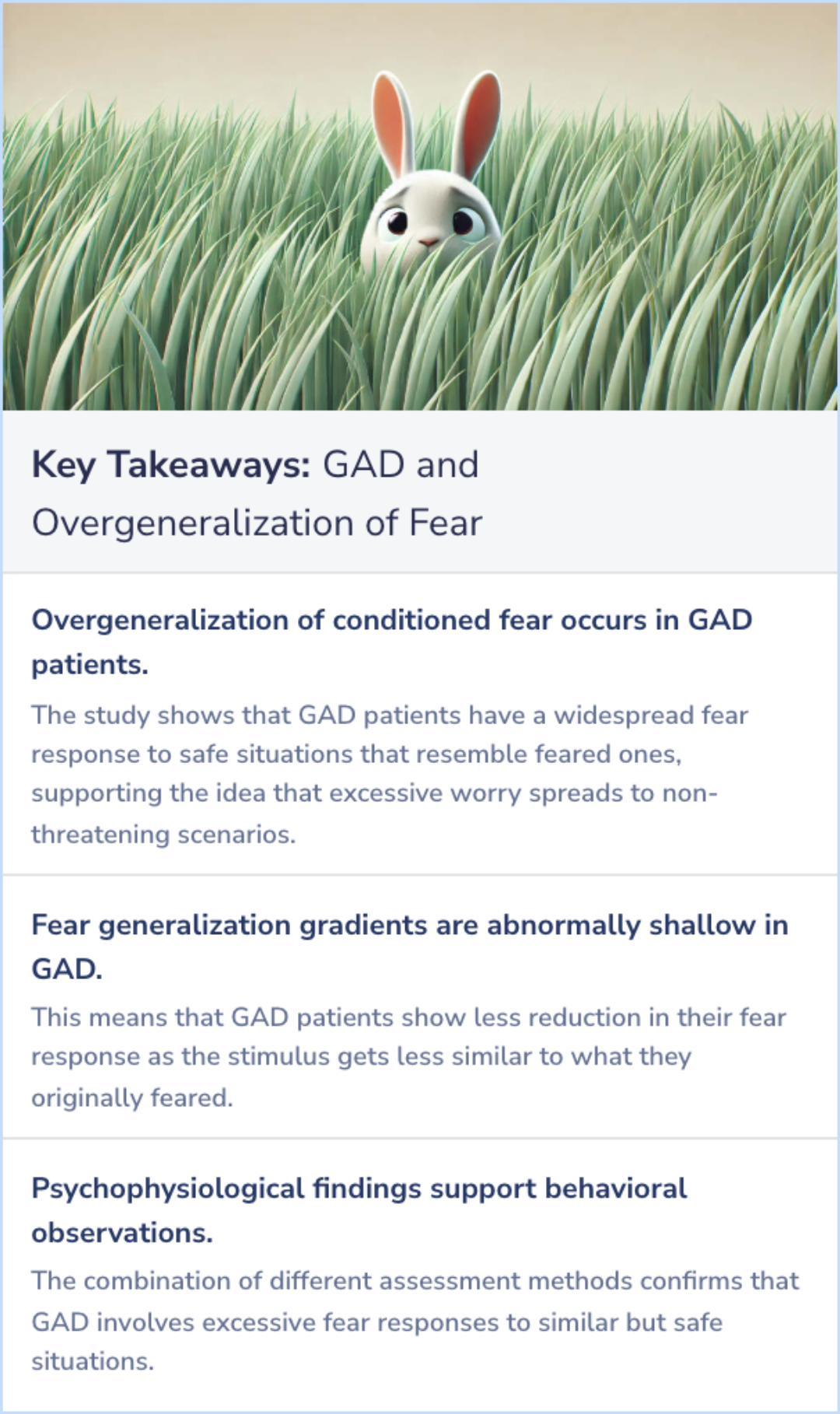
Background Information
Patient Guide
😟
Symptoms of GAD: Chronic Anxiety
GAD involves persistent, unrealistic worry about everyday things, significantly impacting daily life.
🤕
Physical and Behavioral Manifestations
Common physical symptoms in GAD include muscle tension, headaches, and trouble sleeping.
🧠
Biological Underpinnings
Genetic predispositions and neurotransmitter imbalances like serotonin and norepinephrine play a role in GAD.
😰
Generalization of Fear
Fear-conditioning studies indicate that anxiety disorders often include generalization of fear to stimuli resembling danger cues.
🔗
Comorbidities With GAD
GAD frequently coexists with other mental health issues like depression, complicating diagnosis and treatment.
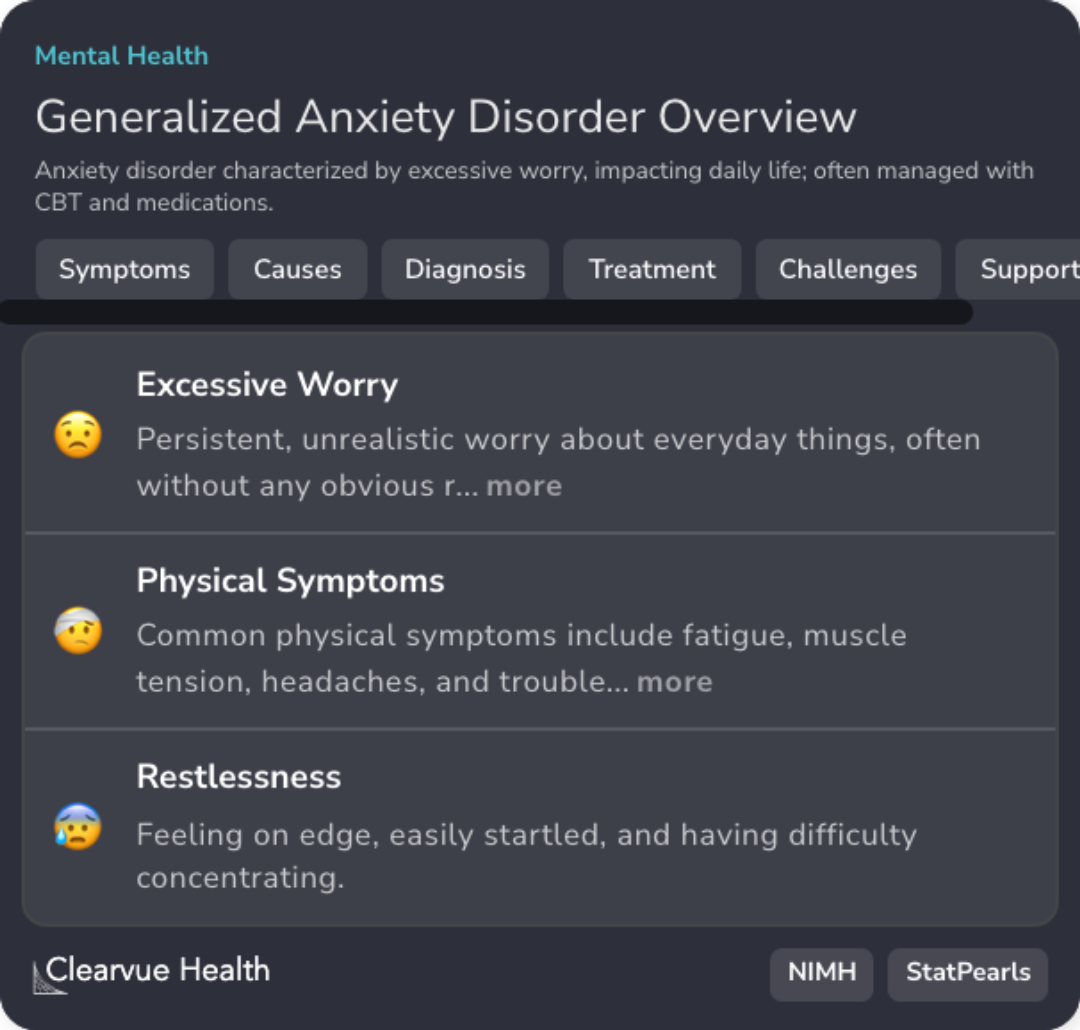
Professional Guide
Expert Opinion: GAD and Overgeneralization of Fear
The findings suggest that overgeneralization of conditioned fear may play a significant role in GAD pathology. Current professional recommendations state that while both pharmacotherapy and CBT offer effective treatments for GAD, the choice of treatment may depend on various factors including therapist competence and patient-specific issues like comorbidity with major depression. CBT techniques encompass a range of interventions, such as cognitive restructuring and exposure, and generally span 10 to 15 sessions. In light of the abstract findings, using tools like the GAD-7 to monitor symptom changes can be beneficial.
Evidence Summary
Managing Anxiety through Integrated Therapy Approaches
Cognitive Behavioral Therapy (CBT) offers ways to manage anxiety by shifting negative thought patterns. Integrated techniques combine traditional CBT with other approaches, aiming to reduce anxiety symptoms more effectively. This method introduces multiple therapeutic tools to create a more comprehensive treatment plan.
Combining different therapies, rather than relying on just one, could lead to a greater reduction in symptoms for individuals with anxiety disorders.
Combining different therapies, rather than relying on just one, could lead to a greater reduction in symptoms for individuals with anxiety disorders.
Evidence Summary
Comparing Treatments for Generalized Anxiety Disorder
The article reviews various studies comparing treatments for generalized anxiety disorder. It looks at multiple methods and assesses their effectiveness in reducing anxiety symptoms. The focus is on identifying which treatments offer the most significant symptom relief, using data from different studies to provide a comprehensive analysis.
Key findings highlight the comparative efficacy of different therapeutic approaches in managing generalized anxiety disorder symptoms.
Key findings highlight the comparative efficacy of different therapeutic approaches in managing generalized anxiety disorder symptoms.
Evidence Summary
Reducing Anxiety in GAD Through Attention Modification
The article explores how attention modification techniques aid individuals with Generalized Anxiety Disorder (GAD) by reducing their focus on worry and anxiety and shifting it towards neutral or positive thoughts, thereby improving their daily life.
Attention modification involves training to focus less on anxiety-provoking thoughts and more on neutral or positive thoughts, which helps alleviate the daily impact of excessive worry and anxiety.
Attention modification involves training to focus less on anxiety-provoking thoughts and more on neutral or positive thoughts, which helps alleviate the daily impact of excessive worry and anxiety.
